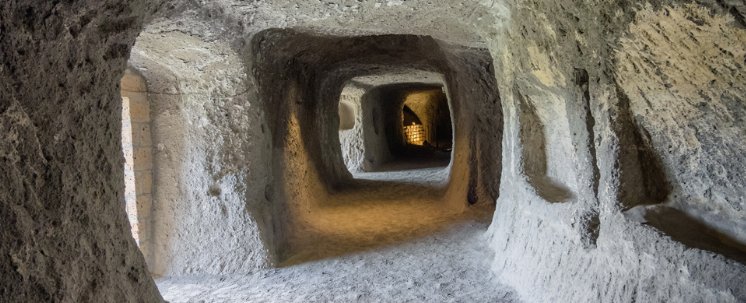Orvieto Underground
Under the city of Orvieto, in the rocky bowels of the cliff, there is an unexpected world of tunnels, caves and underground cavities.
This maze of intricate routes is the result of the millenary work of man, which began in ancient times and continued until the fervent medieval age.
Today, the underground Orvieto gives us a priceless heritage of artifacts and evidences that help us to better understand the daily life of the most ancient centuries and to appreciate the ingenuity of families of workers who have inhabited these places throughout history.
The underground wonders of Orvieto
The anthropized subsoil of Orvieto consists of 1200 tunnels dug into the ground, which intersect without a precise design, but rather represent the result of dozens and dozens of man-made interventions in different periods, depending on the need of the moment.
For example, we can find wells, cisterns and ducts dating back to very ancient times, probably to the Etruscan era of almost three thousand years ago.
And then kilns, oil mills, stables and warehouses that tell a story of everyday life to be experienced, yet hundreds of years away from us.
The well of Saint Patrick
The most famous example of the excavation activity in Orvieto is certainly the famous Well of Saint Patrick, a formidable application of medieval engineering.
The well was built in 1527 by Antonio da Sangallo the Younger on the orders of Pope Clement VII, who at the time had taken refuge in Orvieto after the Sack of Rome, leaving the Vatican in disguise. The well, therefore, had the purpose of ensuring the supply of water in case of another attack.
A peculiar characteristic of the Well of Saint Patrick is the double helicoidal staircase, designed in such a way as to guarantee an unobstructed passage for the pack animals that descended and those that ascended.
The Quarry Well
Another magnificent underground site of Orvieto is the Quarry Well, also built on the orders of Pope Clement VII in the same circumstances described above.
The well, which is over 30 metres deep, was built on the same site where, about 2500 years ago, the Etruscans already built a more rudimentary one to supply themselves with underground spring water.
Used only until the mid-seventeenth century, the well was later abandoned and, according to legend, it was used mainly to cover crimes or to throw the bodies of criminals and the destitute into the depths.
The Majolica Museum
The Museum of Medieval and Renaissance Majolicas in Orvieto is also of great interest, where it is possible to rediscover the fascination of the craftsmanship of many centuries ago.
The site shows how the production of the time was repetitive, with the creation of mass-produced products that were all identical, such as cups, amphorae and other pottery, which sometimes bore remarkable decorations that were rather unusual for the time.
The guided tour of Orvieto Underground
One of the most popular itineraries for tourists to discover the wonders of the underground city is certainly Orvieto Underground, a guided tour that runs through ancient tunnels and charming caves designed for various uses.
A visit to Orvieto Underground will lead you to the discovery of an ancient oil mill with its large millstone, quarries, wells, aqueducts and shops where the locals once carried out part of their daily work activities.
One of the attractions that will arouse most interest is the columbarium rooms, large rooms connecting with the outside, whose walls appear perforated by several sets of small square openings. These cavities were made for the breeding of pigeons, animals whose meat was considered valuable especially in the diets of women who had recently given birth, children and the elderly.
The route is easily covered in about an hour, preferably with gym shoes, and is completely directed by experienced and qualified local guides.
A mysterious and fascinating underground world
Orvieto underground, with its secrets and mysterious charm, is one of the most unique attractions of the city, a surprising journey through the history of these places that since Etruscan times have revealed the ingenuity and industriousness of man.
A visit to one of the routes described above will help you to get to know this city, already unique in its kind and also to discover aspects of the life of a time that we now consider lost and that therefore represent an even more precious treasure.


